According to a couple of old books I read, Phnom Penh used to be the ‘Pearl of Asia‘ in the days when it was occupied by the French. Since then, it has gone backwards. First, thanks to a series of incompetent Cambodian governments, second, thanks to the Khmer Rouge who drove the inhabitants from the city to work in the fields. Now it is in the process of recovery as the wealthy elite want to have somewhere nice to live away from the poor and desperate that live in the rest of the country.
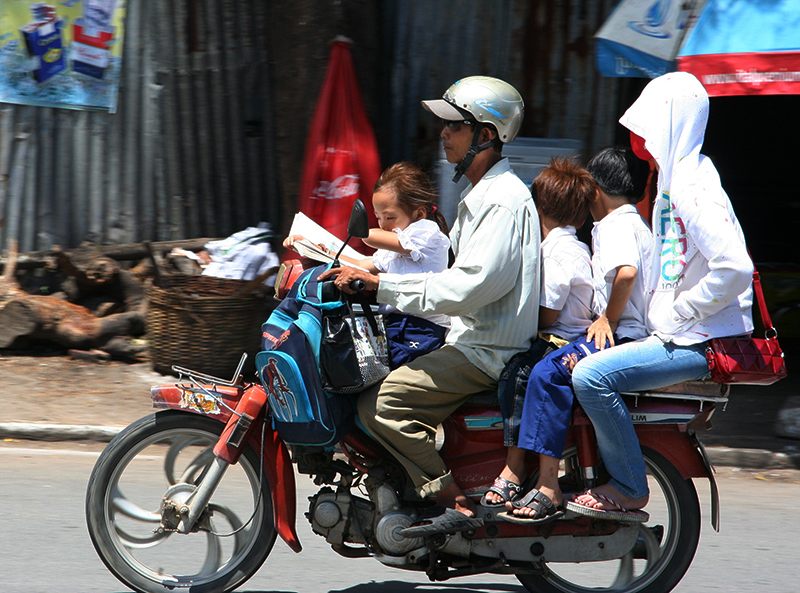 The city enjoys wide, tree-lined boulevards, green open spaces, renovated grand French villas and an array of restaurants serving international as well as traditional Khmer cuisine. The Tonle Sap and Mekong Rivers meet next to a wide, pavemented embankment from which river tour operators run trips along the quiet expanse of slow moving water. Like all Asian cities in this region, bicycles, motorbikes and tuk-tuks throng the streets, but not in anything like the numbers we experienced in China or Vietnam. And in contrast to these latter two countries, there are huge numbers of 4x4s bullying their way around the city. These ‘Chelsea tractors’ are the preferred transport for those with money. Like their urban British counterparts, we don’t see them outside the city, so they are not used to negotiate the rough roads around Cambodia but for short trips about town. It is obligatory to have the manufacturer’s name emblazoned along the sides: Lexus or Toyota they shout from their pristine clean bodies. They are the embodiment of the gap between rich and poor.
The city enjoys wide, tree-lined boulevards, green open spaces, renovated grand French villas and an array of restaurants serving international as well as traditional Khmer cuisine. The Tonle Sap and Mekong Rivers meet next to a wide, pavemented embankment from which river tour operators run trips along the quiet expanse of slow moving water. Like all Asian cities in this region, bicycles, motorbikes and tuk-tuks throng the streets, but not in anything like the numbers we experienced in China or Vietnam. And in contrast to these latter two countries, there are huge numbers of 4x4s bullying their way around the city. These ‘Chelsea tractors’ are the preferred transport for those with money. Like their urban British counterparts, we don’t see them outside the city, so they are not used to negotiate the rough roads around Cambodia but for short trips about town. It is obligatory to have the manufacturer’s name emblazoned along the sides: Lexus or Toyota they shout from their pristine clean bodies. They are the embodiment of the gap between rich and poor.
Pleasant and delightful as Phnom Penh is, it is the enclave of the wealthy and far removed from the rest of the country. Amputated wouldn’t be too strong an adjective. The city’s renaissance is being funded by the millions poured into Cambodia by foreign governments in the form of aid in return for influence. The ruling elite accept it all nonchalantly: nothing gets done without funding from abroad.
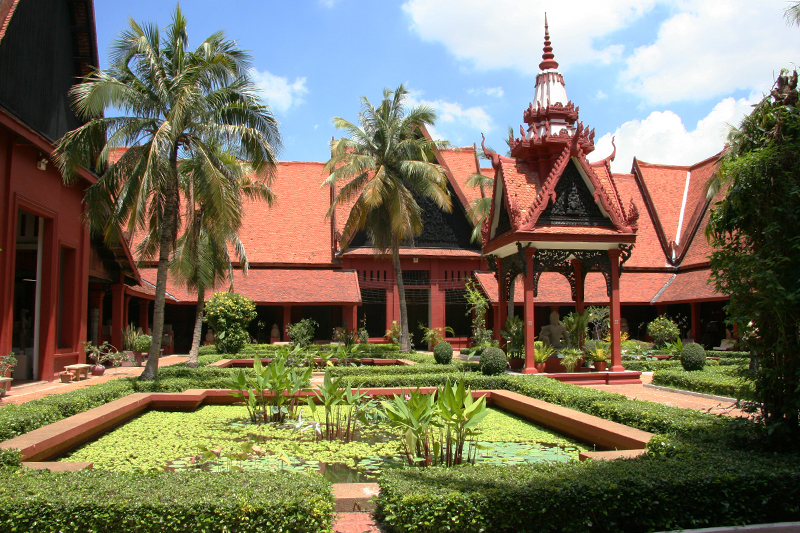 The grand sites are impressive. The Royal Palace dominates the diminutive skyline of the riverfront with its classic Khmer roofs and ornate gilding. Protected behind high walls, it is an oasis of calm with lush gardens and leafy shade that accentuates the simple grand authority of the buildings. Here, royal life could run its course without the unpleasant necessity of mixing with lower beings. The king did not even need to wonder which day of the week it was as courtiers and servants were all required to wear different colours for each day. Today, everyone is wearing red – it must be Monday.
The grand sites are impressive. The Royal Palace dominates the diminutive skyline of the riverfront with its classic Khmer roofs and ornate gilding. Protected behind high walls, it is an oasis of calm with lush gardens and leafy shade that accentuates the simple grand authority of the buildings. Here, royal life could run its course without the unpleasant necessity of mixing with lower beings. The king did not even need to wonder which day of the week it was as courtiers and servants were all required to wear different colours for each day. Today, everyone is wearing red – it must be Monday.
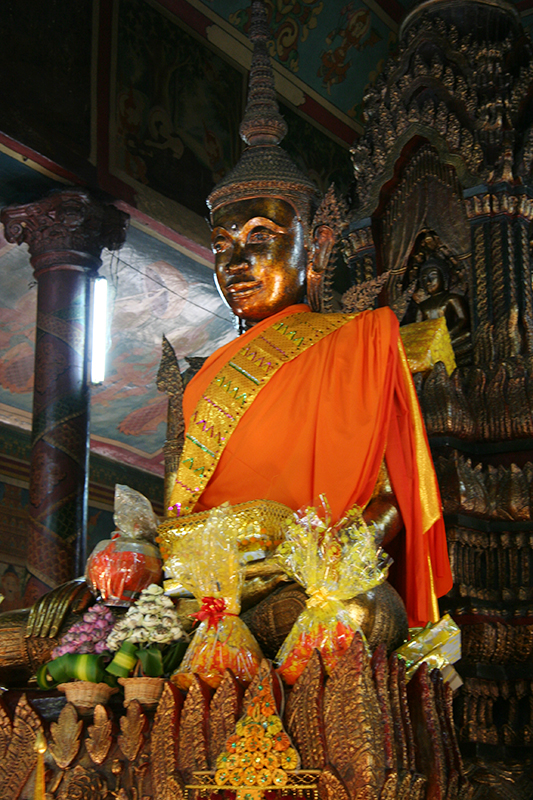 The throne room takes up an entire building. Decorated with gold leaf and with the walls and ceiling painted by hand telling the great stories of past glories. The Silver Pagoda is even more impressive, being constructed with 5,000 floor tiles made from silver that weigh one kilo each. In the centre is a life sized statue of Buddha made from 90kg of solid gold and adorned with 9,584 diamonds. Around the building are several enormous and elaborate stupas, in simple ash grey, that house the final resting place of royalty.
The throne room takes up an entire building. Decorated with gold leaf and with the walls and ceiling painted by hand telling the great stories of past glories. The Silver Pagoda is even more impressive, being constructed with 5,000 floor tiles made from silver that weigh one kilo each. In the centre is a life sized statue of Buddha made from 90kg of solid gold and adorned with 9,584 diamonds. Around the building are several enormous and elaborate stupas, in simple ash grey, that house the final resting place of royalty.
Wat Phnom (meaning hill temple) has also been lavishly preserved. Set on the only ‘hill’ in the city (altitude 27 metres!), it is the legendary spot where Phnom Penh was founded in 1373 by a lady who used it to house four Buddha statues that she recovered floating in the Mekong. Her name was Penh and there is a separate shrine dedicated to her at the back of the main temple. Around the base of the hill is a little park in which locals can relax and enjoy the shade of generous trees, feed the troupe of resident monkeys and watch the sweeping hands of a giant clock set into the hillside.
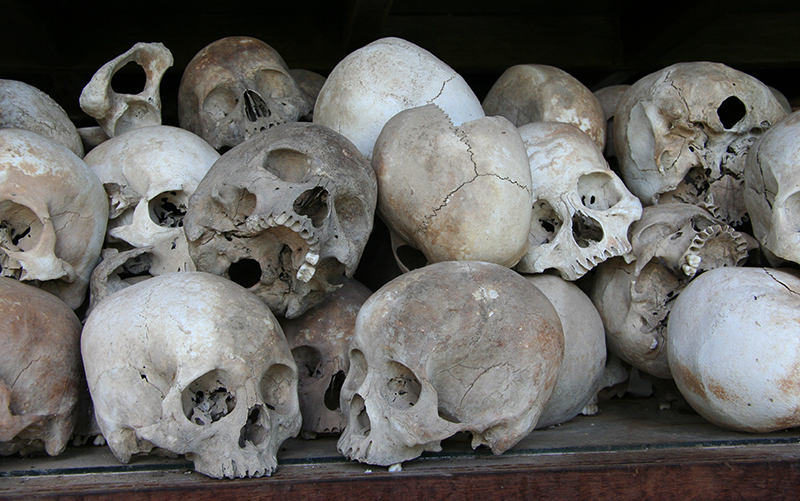 However, despite the grand buildings, the strongest tourist attraction is provided by the chilling remainders of the Khmer Rouge regime. Sitting just beyond the outskirts of the city is the killing field of Choeung Ek where tens of thousands of people were bludgeoned to death to avoid wasting bullets. The executioners could manage to kill ‘only’ 300 people a day and often the condemned had to queue up overnight for death. It is hard to imagine the brutality that took place here when wandering through this peaceful former orchard but the memorial stupa brings much of it home. Within its glass walls lie more than 10,000 skulls of victims arranged into age groups along with assorted bones and a pile of decaying, ragged clothing.
However, despite the grand buildings, the strongest tourist attraction is provided by the chilling remainders of the Khmer Rouge regime. Sitting just beyond the outskirts of the city is the killing field of Choeung Ek where tens of thousands of people were bludgeoned to death to avoid wasting bullets. The executioners could manage to kill ‘only’ 300 people a day and often the condemned had to queue up overnight for death. It is hard to imagine the brutality that took place here when wandering through this peaceful former orchard but the memorial stupa brings much of it home. Within its glass walls lie more than 10,000 skulls of victims arranged into age groups along with assorted bones and a pile of decaying, ragged clothing.
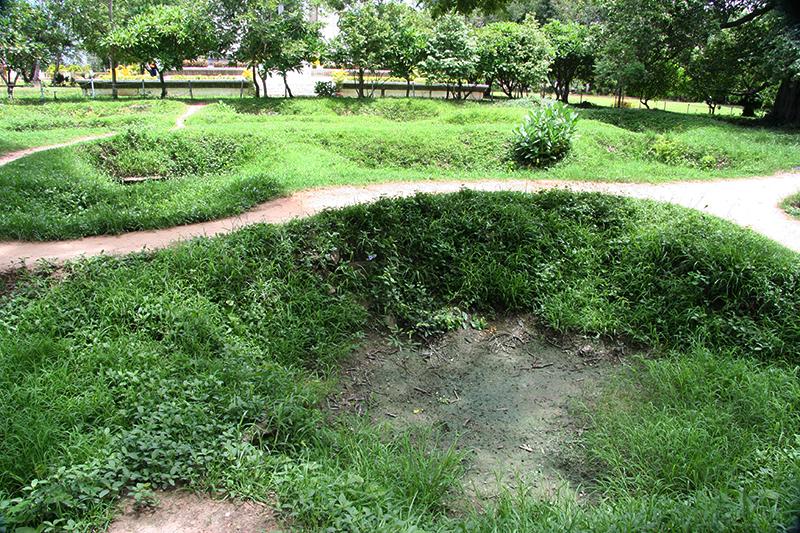 Some of the mass graves, holding up to 150 people each, have been unearthed leaving craters of green grass some of which have blue wild flowers marking the final resting place of unnamed victims whose heads were smashed open. Many other graves remain intact in which countless victims still remain entombed. Between the graves run many sandy paths that are dotted with the bones and clothing of the dead that the rains and the passing of time have forced to the surface. Next to the main path is a large tree that leans at an angle over one of the mass graves where young children were held by the feet before having their heads smashed against the trunk and their corpses dropped into the pit next to the remains of their mothers. It is a very somber place.
Some of the mass graves, holding up to 150 people each, have been unearthed leaving craters of green grass some of which have blue wild flowers marking the final resting place of unnamed victims whose heads were smashed open. Many other graves remain intact in which countless victims still remain entombed. Between the graves run many sandy paths that are dotted with the bones and clothing of the dead that the rains and the passing of time have forced to the surface. Next to the main path is a large tree that leans at an angle over one of the mass graves where young children were held by the feet before having their heads smashed against the trunk and their corpses dropped into the pit next to the remains of their mothers. It is a very somber place.
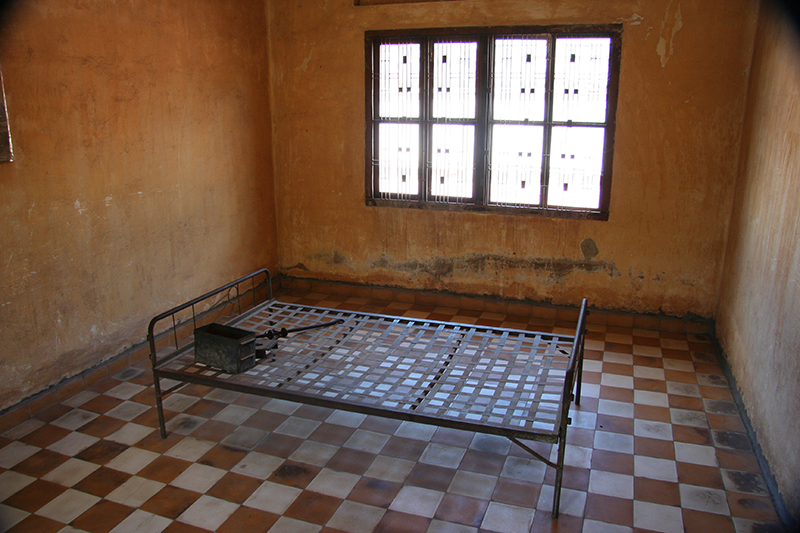 Many of the victims had been brought from the Tuol Sleng security prison, known as S-21. Pol Pot’s security forces turned this former high school into a place of torture for enemies of the revolution, extracting ‘confessions’ from the incarcerated using a number of the most unimaginably unpleasant methods. Twenty thousand people were imprisoned here over the 3 years of Khmer Rouge rule. Only 7 survived.
Many of the victims had been brought from the Tuol Sleng security prison, known as S-21. Pol Pot’s security forces turned this former high school into a place of torture for enemies of the revolution, extracting ‘confessions’ from the incarcerated using a number of the most unimaginably unpleasant methods. Twenty thousand people were imprisoned here over the 3 years of Khmer Rouge rule. Only 7 survived.
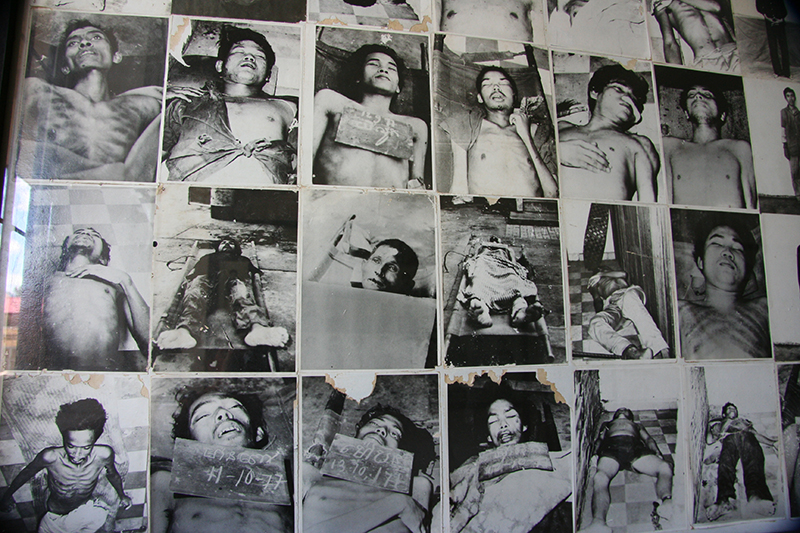 Like the Nazis, the regime was meticulous at keeping photographic records of everyone who passed through on their way to extermination and, today, their photographs line many of the walls.
Like the Nazis, the regime was meticulous at keeping photographic records of everyone who passed through on their way to extermination and, today, their photographs line many of the walls.
If anyone is wondering what has happened to the perpetrators of this genocide, the answer is nothing much. Several high ranking officials have been arrested but, over 30 years after the events, not one has been convicted of a single crime. At the time, the new Cambodian government argued that it would be better to hold trials in Phnom Penh rather than The Hague and, for some reason, the UN agreed. Every person charged with a crime has one Cambodian lawyer and a minimum of two foreign lawyers. On the other side, the prosecution has a number of Cambodians lawyers supported by a host of foreigners. In all, it represents the greatest legal fee feeding frenzy on earth. A large clue as to why the process is taking so long can be found in the Cambodian government, which is populated by former Khmer Rouge members, together with the fact that the trials are funded by overseas governments (Japanese), obviously. Pol Pot has already died (apparently of Malaria) and, with the pace of the legal process, it will surprise no one if the rest of those on trial do not live long enough to be convicted.
I cannot help but feel that the money would better spent helping the poor, rural people find alternative crops other than rice, which no longer suits the dry environment, to provide their meagre living. They are less concerned about the process of bringing the Khmer Rouge to justice than about making sure such unimaginable genocide never happens again.

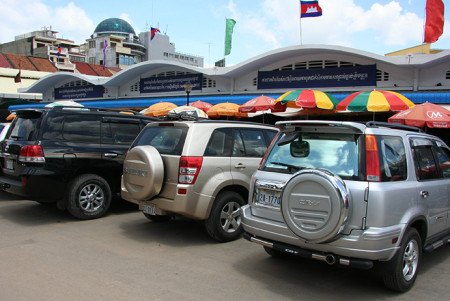
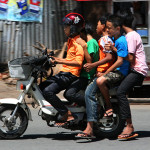
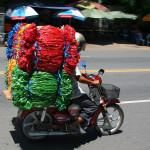
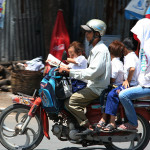
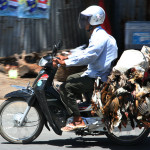
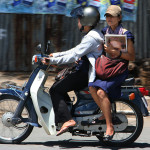
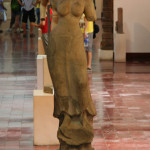
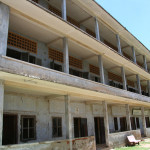
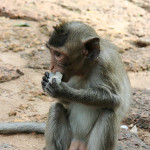
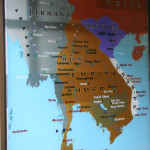
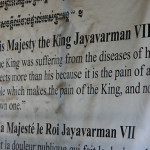
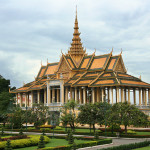
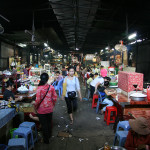
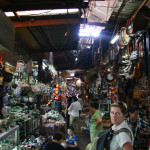
No comments yet.